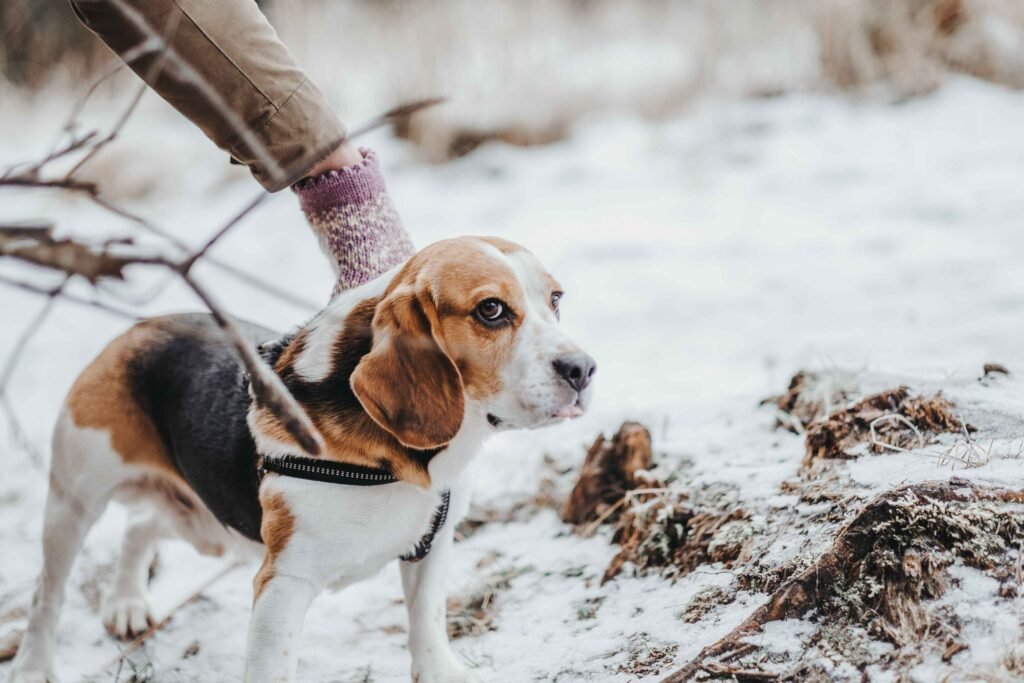Do Beagles Like Snow? The Ultimate Guide
Beagles, with their endearing personalities and playful nature, often captivate the hearts of dog lovers worldwide.
But when it comes to snowy weather, many Beagle owners wonder: do Beagles like snow?
Understanding Beagles and Their Background
To comprehend a Beagle’s relationship with snow, it’s essential to delve into their origins and breed characteristics.
Beagles originated as hunting dogs, renowned for their exceptional sense of smell and boundless energy.
This ancestry plays a pivotal role in understanding their response to various environmental stimuli, including snow.

Do Beagles Like Snow?
Yes, some Beagles do like snow, but it varies depending on the individual dog. Whether Beagles like snow varies among individuals.
Some Beagles enjoy the chilly thrill of snowy adventures, while others may prefer warmth indoors.
Signs of enjoyment include playful behavior, exploration of snowy landscapes, and a relaxed demeanor in cold weather.
Observing your Beagle’s reactions can help determine their preference for snow.
Factors Influencing Beagles’ Response to Snow
Several factors contribute to how Beagles perceive and react to snow. One significant aspect is their coat type and insulation. Beagles with thicker, double coats may fare better in colder climates compared to those with shorter, single-layered coats.
Temperature tolerance also varies among individual Beagles, influenced by factors such as genetics and upbringing. Beagles exposed to snow from a young age may develop a fondness for it, while others might take longer to adjust.
Past experiences with snow play a crucial role in shaping a Beagle’s attitude towards it. Positive experiences, such as fun outdoor play or engaging activities, can foster a love for snow, while negative encounters, such as discomfort or injury, may lead to aversion.
Additionally, like humans, Beagles exhibit unique personality traits that influence their preferences. Some may relish the chilly thrill of snow adventures, while others may prefer cozy indoor settings.
Signs That Indicate Beagles Enjoy Snow
Signs that indicate Beagles enjoy snow can be observed through their behavior and body language.
Firstly, they may display excitement and enthusiasm when presented with snowy conditions, often wagging their tails vigorously and barking joyfully. Beagles that enjoy snow tend to actively engage with their surroundings, eagerly exploring snowy landscapes and sniffing around with curiosity.
Additionally, they may exhibit playful behavior, such as rolling in the snow, chasing snowflakes, or pouncing on snowdrifts.
A relaxed demeanor in cold weather is another sign of a Beagle’s enjoyment, as they may appear content and comfortable while frolicking in the snow. Their willingness to stay outdoors for extended periods without seeking shelter indicates their fondness for snowy activities.
Overall, observing these positive behaviors and reactions can help determine if a Beagle truly enjoys the snowy weather.
Tips for Ensuring Beagles’ Comfort in Snow
Ensuring your Beagle’s comfort in the snow involves several important considerations to keep them safe and content.
Firstly, maintain proper winter grooming by regularly brushing their coat to remove any snow or ice buildup, preventing matting and discomfort. Provide warm shelter and cozy bedding indoors for your Beagle to retreat to when they need a break from the cold.
Additionally, monitor their behavior for signs of discomfort, such as shivering or lifting their paws, and bring them indoors if necessary.
Protect their paws from ice and salt by using paw balm or protective booties, preventing irritation and potential injuries. Limit outdoor exposure during extreme cold or inclement weather conditions, ensuring your Beagle’s well-being.
Finally, pay attention to their individual preferences and adjust accordingly to ensure they remain comfortable and happy in snowy conditions.

Activities Beagles Can Enjoy in Snow
Beagles can have a blast engaging in various activities in the snow, making the most of the winter wonderland.
One enjoyable activity is snowball fetching, where you can toss snowballs for your Beagle to chase and retrieve, providing both physical exercise and mental stimulation.
Another fun option is tracking scents in the snow, tapping into their natural hunting instincts as they follow intriguing smells left behind by wildlife or other animals.
Additionally, Beagles love going on winter hikes and walks, exploring the snowy terrain while enjoying the fresh air and scenery. You can also set up a snow agility course with obstacles like snow mounds or tunnels for your Beagle to navigate, enhancing their agility and coordination.
Ultimately, the possibilities for snowy adventures with your Beagle are endless, ensuring plenty of excitement and fun for both of you.
Precautions for Beagles in Snowy Conditions
While Beagles possess a natural resilience to cold weather, precautions should be taken to ensure their safety.
Limiting exposure to harsh weather conditions, especially during extreme cold or snowstorms, reduces the risk of hypothermia or frostbite.
Protecting their paws from ice and salt by using paw balm or protective booties prevents discomfort and potential injuries.
Regularly checking for signs of frostbite, such as pale or discolored skin, ensures prompt medical attention if needed.
Training Beagles to Adapt to Snow
Training Beagles to adapt to snow requires patience, consistency, and positive reinforcement. Start by introducing them to small amounts of snow gradually, allowing them to become familiar with the texture and temperature.
Use treats and praise to create positive associations with snow, rewarding them for showing curiosity or interest. Encourage exploration by taking short walks in snowy areas, allowing them to sniff around and investigate their surroundings at their own pace.
If your Beagle shows signs of discomfort, such as lifting their paws or shivering, bring them indoors and try again later. Over time, gradually increase their exposure to snow, building their confidence and resilience. With patience and encouragement, your Beagle can learn to enjoy snowy adventures and embrace the winter season alongside you.
FAQs: Beagles
Can all Beagles tolerate cold weather?
While Beagles generally have a tolerance for cold weather, individual differences exist. Factors such as coat type and temperature tolerance play a significant role in determining a Beagle’s comfort level in snow.
How can I tell if my Beagle enjoys playing in the snow?
Watch for signs of excitement and enthusiasm, such as playful behavior, eager exploration of snowy terrain, and a relaxed demeanor in cold weather. Beagles that exhibit these behaviors likely enjoy playing in the snow.
Should I limit outdoor time for my Beagle in winter?
It’s advisable to monitor outdoor exposure during extreme cold or inclement weather conditions. Limiting outdoor time, providing warm shelter, and dressing your Beagle in appropriate winter gear help mitigate risks associated with cold weather.
Are there any specific health concerns related to Beagles and snow?
Beagles are generally resilient to cold weather, but precautions should be taken to prevent issues like hypothermia and frostbite. Regular grooming, protective gear for paws, and monitoring for signs of discomfort are essential for your Beagle’s well-being in snowy conditions.
What should I do if my Beagle shows signs of discomfort in snow?
If your Beagle exhibits signs of discomfort, such as shivering or lifting paws, immediately bring them indoors to warm up. Check for signs of frostbite and seek veterinary attention if necessary to ensure prompt treatment.
Conclusion
In conclusion, Beagles possess a diverse range of responses to snow, influenced by various factors such as coat type, past experiences, and individual temperament. While some Beagles revel in snowy escapades, others may prefer the warmth of indoor coziness.
As responsible pet owners, it’s crucial to respect and accommodate your Beagle’s preferences while ensuring their safety and well-being in snowy conditions.





